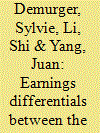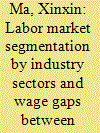|
|
|
Sort Order |
|
|
|
Items / Page
|
|
|
|
|
|
|
| Srl | Item |
| 1 |
ID:
110255


|
|
|
|
|
| Publication |
2012.
|
| Summary/Abstract |
This paper analyzes the changes in public-private sector earnings differentials for local residents in urban China between 2002 and 2007. We find that earnings gaps across ownership sectors decreased during this period and that the convergence trend has been in favor of the private and semi-public sectors as opposed to the public sector. This trend is in sharp contrast to what occurred at the turn of the 21st century when employees in the government and state-owned enterprises were found to enjoy a privileged situation. Differences in endowments are found to play a growing role in explaining earnings differentials. However, although it is becoming less of an issue, segmentation across ownership remains important, especially for high-wage earners.
|
|
|
|
|
|
|
|
|
|
|
|
|
|
|
|
| 2 |
ID:
145030


|
|
|
|
|
| Summary/Abstract |
Why are some countries prone to ethno-nationalist conflict, whereas others are plagued by class conflict? This is a question that has seldom been raised and rarely been examined empirically. This paper presents a social-structural theory to account for the variable incidence of these two forms of political instability. These two types of conflict result from distinct principles of group solidarity – ethnicity and class – and since each individual is simultaneously a member of an ethnic group (or many such groups) and a particular class, these two principles vary in the degree to which they are mutually exclusive or cross-cutting. The degree of economic stratification between groups and economic segmentation within them shapes the relative salience of each principle of group solidarity in any society and is associated with a characteristic form of political mobilization. In places where between-group inequalities are high, and within-group inequalities low, ethnicity should be the dominant principle of group solidarity and serve as the primary basis of group conflict. By contrast, in countries where between-group inequalities are low, and within-group inequalities high, class is more likely to serve as the dominant principle of group solidarity, and conflicts along class lines are more likely. We test these conjectures with data in over 100 countries on cross-cutting cleavages, ethnic war, and class conflict. The results are supportive of the theory, and provide evidence that how groups are stratified and segmented in societies shapes the type of civil war.
|
|
|
|
|
|
|
|
|
|
|
|
|
|
|
|
| 3 |
ID:
161770


|
|
|
|
|
| Summary/Abstract |
This paper explores the influence of labor market segmentation by industry sectors on the wage gap between rural-to-urban migrants and local urban residents in China in the 2000s. Using Chinese Household Income Project (CHIP) survey data and the results based on the Brown decomposition method, the results indicate that the influence of intra-industrial differentials is greater than the influence of inter-industry differentials in both 2002 and 2013. The influence of the explained component of the intra-industry differentials is larger in both 2002 and 2013, and the influence of the unexplained component of the intra-industrial differentials rises steeply from 2002 to 2013. These results show that the individual characteristic differentials (e.g. human capital) in the same industry sector is the main factor causing the wage gap in both 2002 and 2013, and the problem of discrimination against migrants in the same industry sector became more serious from 2002 to 2013.
|
|
|
|
|
|
|
|
|
|
|
|
|
|
|
|
| 4 |
ID:
111428


|
|
|
|
|
| Publication |
2012.
|
| Summary/Abstract |
A multivariate statistical approach to lifestyle analysis of residential electricity consumption is described and illustrated. Factor analysis of selected variables from the 2005 U.S. Residential Energy Consumption Survey (RECS) identified five lifestyle factors reflecting social and behavioral patterns associated with air conditioning, laundry usage, personal computer usage, climate zone of residence, and TV use. These factors were also estimated for 2001 RECS data. Multiple regression analysis using the lifestyle factors yields solutions accounting for approximately 40% of the variance in electricity consumption for both years.
By adding the household and market characteristics of income, local electricity price and access to natural gas, variance accounted for is increased to approximately 54%. Income contributed ~1% unique variance to the models, indicating that lifestyle factors reflecting social and behavioral patterns better account for consumption differences than income. Geographic segmentation of factor scores shows distinct clusters of consumption and lifestyle factors, particularly in suburban locations. The implications for tailored policy and planning interventions are discussed in relation to lifestyle issues.
|
|
|
|
|
|
|
|
|
|
|
|
|
|
|
|
| 5 |
ID:
192390


|
|
|
|
|
| Summary/Abstract |
We study the changing landscape of credit market guarantees by examining the risk-pricing of the Chinese state-owned enterprise (SOE) bonds, which have experienced rising defaults across provinces from a zero record. Using primary market bond issuance data, we identify a province premium that captures the perceived local government support for local SOEs. We find that on average the perceived local government support is on the decline, while the subnational debt market has become more segmented since 2018. This evidence is found to be closely related to the divergence in local government’s fiscal space and the occurrence of SOE default incidents in the area, highlighting the adverse linkage between public debt and corporate financing costs.
|
|
|
|
|
|
|
|
|
|
|
|
|
|
|
|
|
|
|
|
|